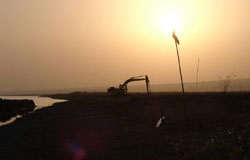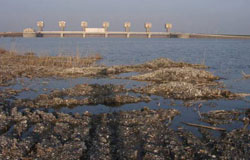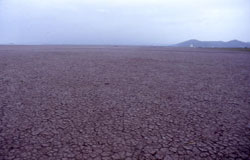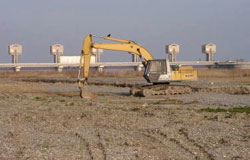
The Isahaya:
Section A. What Happened in 1997?
 
According to a newspaper article dated on August 17th, 1997, the government
of Japan - the Ministry of Agriculture, Forestry and Fisheries and the
Environment Agency (now the Ministry of the Environment) -- sent letters
regarding the Isahaya Reclamation Project in response to inquiries from
the Ramsar Convention Secretariat.
Both the Ministry of Agriculture, Forestry and Fisheries and the Environment Agency (now the Ministry of the Environment) said that an EIA was carried out prior to the project together with a follow-up monitoring of wild birds and that no waterbird species will be extinct due to the project.
However, it is pointed out that such a conclusion contradicts with official statement by the government at the National Diet (Parliament) confirming that no comprehensive investigations on migratory bird species were carried out covering all tidal mudflats within the Ariake Bay.
According to sources including the Ministry of Foreign Affairs, the National League of Environmentalists based in Tokyo submitted a letter to the Ramsar Secretariat requesting a recommendation to suspend the Isahaya Reclamation Project. The Ramsar Secretariat inquired data over impacts on migratory birds by the project. The Ministry of Agriculture, Forestry and Fisheries and the Environment Agency answered respectively to the Secretariat through the Ministry of Foreign Affairs between May and July 1997.
Their letters are almost identical and clarified the following:
Migratory birds such as shorebirds visiting the Isahaya Bay also use other tidal flats -- estuaries of River Chikugo in Fukuoka Prefecture and Kashima tidal flats in Saga Prefecture and move among those areas; and main foods such as crabs and shellfish for wild birds are abundant in those areas and therefore no waterbird species will be extinct due to the Isahaya Reclamation Project.
Main purposes of the project are:
- Creating agricultural lands of high productivity;
- Enhancing disaster prevention functions.
Environmental measures taken for the project are:
- Environmental monitoring;
- Facilitating restoration of tidal mudflats. Mudflat areas grow annually
in front of embankments within Ariake Bay. Mudskippers distribute widely
through tidal mudflats within Ariake Bay and its fish catch increases these
years. Besides incubation techniques for this fish species have been nearly
established. Therefore this species will not extinct due to the project;
- Wild birds monitoring. Research works were carried out using small radio
telemetry for plovers and other wild bird species. Such researches revealed
that those birds move substantially among tidal flats within Ariake Bay.
Main foods such as crabs and shellfish for wild birds are abundant in those
areas and therefore no waterbird species will be extinct due to the Isahaya
Reclamation Project.
 
During the Ramsar Kushiro Conference (COP5) in 1993, both the Japanese
Government and NGOs reported the remaining mudflat areas in Japan were
rapidly disappearing mainly due to development plans in coastal areas.
The representative of Japanese NGOs pointed out that four major tidal mudflat areas in Japan are endangered.
Isahaya Bay, one of those four major mudflat areas, has now been dried
up since the official shutdown of 7-km-long Sea Wall on 14 April 1997.
The Sea Wall cut off the water of Isahaya Inner Bay from the Ariake Sea.Although
Isahaya Bay deserves the status of a wetland of international importance,
the Japanese Ministry of Agriculture, Forestry and Fisheries claims that
the project is inevitable for flood control and more agricultural lands.
However, since the official shutdown of the Wall, there has been hue and cry throughout Japan against the project. Newspaper articles and TV programs over Isahaya issues were plenty. Several National Diet members have investigated the site and officially opposed the projects. They request the Ministry of Agriculture to open the sluices of the Wall while more discussion about the project is needed.
Conservation NGOs have raised several questions: this project is the only and best way for flood control?; similarly, we really need more reclaimed lands for agricultural purpose today?; we are losing this valuable and LARGEST mudflat area in Japan simply because mega-development schemes are unstoppable?
Section B. Why It Matters.
Isahaya Bay Debate: A dying mudflat area in Japan
Few have questioned why Japan's supposed "cities of future" are unable to do something as basic as burying telephone wires; why gigantic construction boondoggles scar the countryside (roads leading nowhere in the mountains, rivers encased in U-shaped chutes); why wetlands are cemented over for no reason;
Alex Kerr (2001) "Dogs and Demons - the Fall of Modern Japan"
Penguin Books
The story of Isahaya Bay is a good example of the "unstoppable" force of bureaucratic inertia. In the mid-1960s the Ministry of Agriculture, Forestry and Fisheries (MAFF) drew up a plan to reclaim this bay near Nagasaki, Japan's last major tidal wetland. The tides in Isahaya can rise to five meters, among the highest in Japan, and they nurtured a rich sea life in the bay's wetlands, where about three hundred species lived, including rare mudskippers and a number of endangered crabs and clams. On April 14, 1997, everything began to die when officials closed off the waters behind the first part of a seven-kilometer embankment.
The original idea was to provide new fields for farmers in the area. But the number of farmers, which had begun to drop in the 1960s, fell rapidly thereafter, and was reduced to almost half between 1985 and 1995. That nobody would farm these new fields posed a serious problem for MAFF, because the Isahaya drainage project, at \237 billion, was a very large civil-engineering program, a keystone of the ministry's construction budget. So it relabeled the plans a "flood-control project," even though experts believed that the last flood, in 1957, had been of the sort that comes only once every hundred years.
Major projects involve decades of bargaining with vested interests as to the amount of their payoffs, or "compensation," and at Isahaya this long preparatory period ended in the early 1990s. The fishing and farming groups in Isahaya could not refuse a largesse that amounted to hundreds of millions of yen. But this compensation was the gold for which such local groups sold their souls to the devil, for once they received the payoff they could never refund it. Many towns in Japan, having decided to reconsider a dam, nuclear plant, or landfill they have agreed to, learn to their sorrow that the citizens have received more money than they can possibly repay.
In the late 1980s, a group of environmentalists began to object to the Isahaya drainage project. Opposition grew, but MAFF went on steadily building the seven-kilometer dike that shut the wetlands off from the sea. By the time the villagers began to question the project, it was too late.
Enter the Environment Agency, whose role shows how the Construction State has led to strange mutations in the shape of the Japanese government, rather like those crabs that grow an enormous claw on one side while the other side atrophies. While the River Bureau of the Construction Ministry, originally a minor office, has burgeoned into a great empire with a budget surpassing those of many sovereign states and with almost unlimited power to build dams and concrete over rivers, the Environment Agency has shriveled. Starved of a budget and without legal resources, it has ended up a sleepy back office with a dusty sign on the door and very little to do, having been reduced to rubber-stamping the projects of its bigger and stronger brother agencies.
In 1988, only a year before construction of the Isahaya dikes was to begin (but decades after MAFF began planning and negotiating the payoffs), the Environment Agency made a "study" of it all, followed almost immediately by approval with a few minor restrictions. When MAFF closed the dikes in April 1997, it was clear that the Environment Agency's study had been a cursory travesty. Assailed by the media, the only comment of agency chief Ishii Michiko was this: "The result might have been different if the assessment had followed today's environmental standards. . . . But it is unlikely that we will ask the Agriculture Ministry to re-examine the project." In other words, although the Environment Agency was aware that the drainage of the Isahaya wetlands was a disaster, it did not move to stop the project. And why should it? Allowing Japan's last major wetland to die shouldn't concern anyone. MAFF chief Fujinami Takao commented, "The current ecosystem may disappear, but nature will create a new one."
And so it stands. The tideland is dead now, and for no better reason than the necessity for MAFF to use up its construction budget. When asked what Isahaya would do with the drained land, the town's mayor, its most strenuous supporter, had no clear idea. "We are considering using the reclaimed land for growing crops, raising dairy cows, or breeding livestock," he replied. But apparently there are even better uses for land that no one knows what to do with. He added, "We have also studied setting up a training center for farmers from Southeast Asia or conducting biotechnology research."
D. A. Scott and C. M. Poole (1989) "A Status Overview of Asian Wetlands"
Although many of Japan's wetlands have disappeared as a result of rapid development in the recent past, the country still possesses a wide diversity of wetland ecosystems of considerable importance for wildlife including a number of threatened species. Many protected areas have been established, and considerable efforts are being made by the conservation bodies to prevent further wetland loss. However, the pressure on wetlands remains severe, particularly from canalization of river channels and conversion of coastal marshes and mudflats to agricultural land and industrial development.
- Priority Sites
- 1 Sarobetsu -- upgrade
4 Kushiro Marsh -- threat, upgrade, manage, species
- 5 Lake Utonai -- threat
13 Shiokawa -- threat, upgrade
- 14 Shonai-Fujimae Tidal Flats and Inner Ise Bay -- threat, upgrade, educate
17 Lake Shinji and Lake Nakaumi -- threat >21 Ariake Bay -- threat,
protect
- Priority Species
- Gorsachius goisagi, Anas Formosa, Haliaeetus pelagicus, Grus monacha, G. japonensis, G. vipio, Ketupa blakistoni, Megalurus pryeri, Andrias japonicas*
D. A. Scott (1989) "A Directory of Asian Wetlands"
Ariake Bay (21)
Area: 180,000 ha (maximum of 30,800 ha of tidal mudflats)
A large shallow sea bay with many estuaries and the largest area of intertidal mudflats in Japan. The mudflats extend in fingers for up to 7 km out from the estuaries of the many rivers entering the bay. The total area of mudflats continues to decrease as more and more land is retained within concrete banks and reclaimed for agriculture.
The average depth of water in the bay is 20m (maximum of 130m), and the maximum tidal variation is 5-7 m.
Section C. History of the Isahaya Reclamation Project and relevant events
| 1952 |
|
The Governor of Nagasaki Prefecture announced the "Nagasaki Great Reclamation Plan". |
| 1957 |
|
Isahaya Big Flood; 682 people were killed. |
| 1964 |
|
The Nagasaki Great Reclamation Plan became the Nagasaki Reclamation Project and was approved in order to increase rice production. The whole Isahaya Bay, the area of which is 10,000 ha, was to be cut off. |
| 1965 |
|
12 fishermen's cooperatives within the Isahaya Bay organized a committee
to oppose the Project. 400 fishing boats protested over the sea. |
1970
|
January |
The government's policy to reduce paddy fields began, and consequently the reclamation project was abandoned. |
|
December |
The modified project - the "South Nagasaki Comprehensive Development
Project (SouthCom)" -- was submitted to secure water resource and
to increase farmlands. |
| 1977 |
|
Fishermen's coalition from three prefectures along the Ariake Sea coast,
namely Fukuoka, Saga, and Kumamoto prefectures, organized the Society to
Oppose the Southcom. |
| 1980 |
|
The Government of Japan acceded to the Ramsar Convention. |
| 1981 |
|
Ten fishermen's cooperatives out of 12 had agreed upon the reclamation
by March. The fishermen's cooperative in Konagai Town had not agreed. But
it agreed upon the reclamation in August. The last standing fishermen's
cooperative in Mizuho Town agreed in October. Compensation schemes with
those 12 fishermen's cooperatives were signed. The total amount for compensation
was 32.28 billion yen. |
| 1982 |
|
The Nagasaki Big Flood killed 299 people in July. The Minister of Agriculture,
Forestry and Fisheries (MAFF) announced the cancelation of the SouthCom
due to the failure to obtain approval from people outside the Isahaya Bay.
However, it was suggested that the new reclamation proposal should be investigated
and promoted and that the main purpose of the new reclamation project should
be flood control. |
| 1983 |
|
MAFF established a committee to consider flood control in Isahaya Bay. The committee then submitted a proposal to reduce the cut down area to 3,900 ha. |
| 1985 |
|
The fishermen's coalition from the above-mentioned three prefectures had insisted that the cut down area should be less than 3,000 ha. Then the compromising plan to cut down 3,500 ha was submitted and approved by the fishermen's coalition. |
| 1986 |
|
The Kyushu (Island) Agricultural Policy Bureau submitted a draft environmental
impact assessment (EIA) in September. Nagasaki Prefectural government and
12 fishermen's cooperatives within Isahaya Bay signed a fisheries compensation
agreement with the compensation as much as 24.35 billion yen. The prefectural
government and 11 fishermen's cooperatives signed another compensation
agreement with the compensation of 1.2 billion yen.
MAFF submitted a request for approval to reclaim a public water surface to the Governor of Nagasaki prefecture. The Governor approved the request. The total cost projected was 135 billion yen and the project was to be finished in 2000. |
| 1989 |
|
The project was started in November. |
| 1992 |
|
The tidal dam construction works were started. A lot of bivalve shellfish
within Isahaya Bay started dying. |
| 1993 |
June |
The Ramsar COP5 (the first Ramsar COP in the Asian region) was held in Kushiro.
The Kyushu Agricultural Policy Bureau has settled a committee to investigate the cause of mass dying of bivalves in fishery grounds within Isahaya Bay. Bivalve fisheries there ceased since this year. |
| 1997 |
April |
A ceremony was conducted to put down 238 iron gates to complete the sea wall of the tidal dam. |
| 1999 |
|
MAFF modified the project. The total cost projected became 249 billion yen and the project was to be completed in 2006 but not in 2000 as planed previously. |
| 2000 |
|
25 fishermen from Saga prefecture appealed in March in front of the northern iron gate, requesting to open the gate. Other fishermen also appealed on 70 boats. |
|
A big red tide with … prevailed over Ariake Sea in December and damaged local seaweed production.
Seaweed: Nori or laver became pale and its production was very low. |
| 2001 |
January |
The Environmental Agency became the Ministry of the Environment. |
|
1,000 fishermen from four prefectures, namely Nagasaki, Saga, Fukuoka and Kumamoto, protested on 400 boats in January. The second protest was conducted with 1,200 fishermen on 300 boats. MAFF established an office to deal with low productivity of Nori in Ariake Sea. Then the third protest conducted with 6,000 fishermen on 1,300 boats from Saga, Fukuoka and Kumamoto prefectures. |
| February |
MAFF settled a committee for investigation and reviewing to deal with low productivity of Nori and other issues. The committee was then usually called as the third-party committee. |
| June |
Another third-party committee, established by MAFF to review national projects, started its reviewing process. |
| August |
The committee to review national projects recommended the re-arrangement
of the Isahaya Bay reclamation project paying attention to environmental
factors. MAFF announced the re-arrangement recommended including the reduction
of reclaimed land. |
| October |
The Minister announced the re-arranged plan, according to which the reclaimed
land area became an half of the original plan. |
| December |
The Governor of Nagasaki accepted the re-arranged plan in condition of
resuming the reclamation works. On the other hand, the third-party committee
for Nori (laver) proposed investigations with opening sluices for three
different periods: short-term investigation with opening sluices for two
months; medium-term investigation with opening sluices for about half a
year; and long-term investigation with opening sluices for several years. |
| 2002 |
April |
The short-term investigation started with opening sluices. |
| November |
The Special Act for Ariake Sea was passed. |
| 2003 |
March |
MAFF settled a committee to consider medium-term and long-term investigations. Members, however, comprise of former senior government officers. |
| November |
MAFF publicized the report of the short-term investigation. The report said: the shutting down of the sea wall influences mostly the inner Isahaya Bay but only little to outside the bay. |
| December |
The committee to consider medium- and long-term investigations reported
its conclusion that is negative to such investigations. |
| 2004 |
February |
Fishermen's coalition from three prefectures, Saga, Fukuoka, and Kumamoto,
submitted their request for medium- and long-term investigations. |
| April |
800 fishermen demonstrated on 150 boats, requesting medium- and long-term investigations. |
| May |
MAFF announced his opinion not to carry out medium- and long-term investigations. |
| August |
The Saga local court decided the suspension of the Isahaya reclamation works, admitting relationship between the reclamation works and damages on local fisheries. |
| 2005 |
March |
the Nagasaki local court did not recognize the appropriateness of local wildlife as accusers for the "case on nature's right at Isahaya Bay". |
| May |
The Fukuoka high court did not deny the relationship between the Isahaya
reclamation works and damages on local fisheries, but said that evidences
are not enough and cancelled the conclusion of the Saga local court to
suspend the reclamation works. |
| July |
Additionally 1,100 people joined the "lawsuit to restore Ariake Sea", increasing the total number of plaintiffs to 2,000. |
| August |
The arbitration committee for pollution and other environmental issues
did not admit the relationship between the Isahaya reclamation works and
damages on local fisheries and dismissed the request from local fishermen
to confirm the cause of damages. |
|